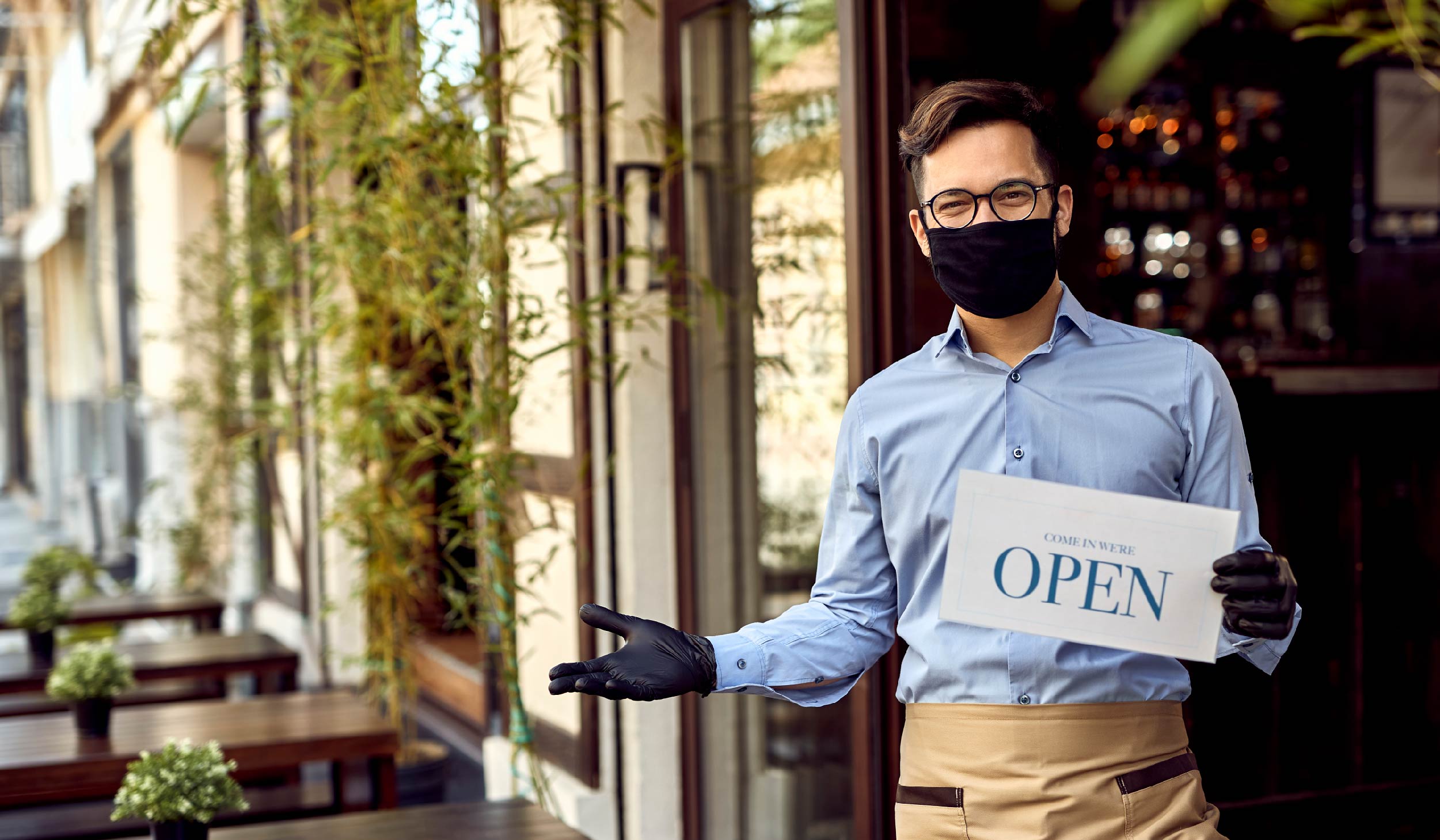
COVID-19 Tune Up: Beat the Odds Today15 min read
As restaurants across the country resume operations, we want all restaurant owners and operators to be aware of the following COVID-19 management guidelines. The COVID-19 crisis is unprecedented in recent history and may have widespread implications for our industry. It’s imperative that all restaurant owners follow these guidelines—for the good of the industry as a whole. We must remain vigilant so that we can safeguard the safety and health of our guests.
For this reason, we ask those reading this post to share it. Doing so helps us reach more owners/operators, and we can, as an industry, increase our chances of making a strong recovery. We thank you for your patience and understanding as we continue to explore the COVID-19 crisis.
In this post, we cover several mission-critical COVID management techniques. We’ll explore:
-
How to offer customers low risk food and beverages
-
How to slow the spread of the virus
-
How to create and maintain a healthy and sanitary workplace environment
-
How to handle sick employees
It’s our hope that by putting this material in one place we can help many owners/operators survive this stressful time.
Before we reveal how to do all of the above, let’s check the news.
In the News
New COVID cases in the U.S. are on the decline. But many health officials are warning that fewer new cases doesn’t necessarily mean great progress overall. For instance, some states, like Kansas, have new cases in every county. And the University of Alabama alone has reported over 500 new cases. Don’t get complacent, folks. When you read that cases are down overall, this means across the entire country. But the virus is still spreading aggressively in isolated pockets. These pockets of growth can easily translate into a glut of new infections. If folks become complacent now, the overall number of new cases may increase.
In other news, some experts are cautioning that the virus may spread primarily through aerosols, and not droplets, as was once thought. Infected individuals expel droplets when they cough or sneeze. Some experts have long maintained that these droplets sink to the floor after traveling around four feet.
Aerosols are like droplets, but they’re much smaller in size. Indeed, these tiny droplets can remain suspended in the air for hours. A human hair is around 80 microns. But an aerosol is around 50 microns. Quite small. A single aerosol can hold hundreds of SARS-CoV-2 viruses. Therefore, it’s more important than ever to use masks when out and about.
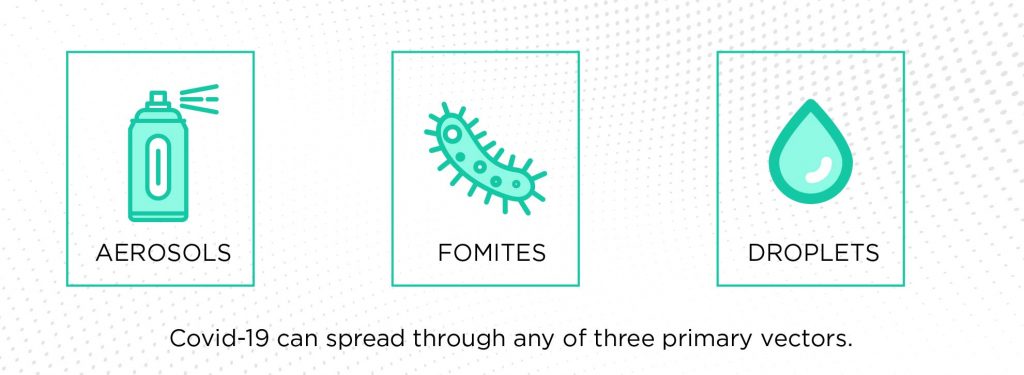
COVID-19: Essentials
Regardless of how the virus is spread, what’s known for sure is that a person’s risk of infection scales with how long they’re around other infected people. In a restaurant setting, the risk of viral spread breaks down like this:
Low risk.
Restaurants that offer only delivery, take-out, drive-through or curbside
Moderate risk.
The restaurant focuses on offering delivery, take-out, curbside or drive through but also offers on-site dining. However, on-site dining is outdoors only. In addition, seating capacity is reduced and tables are at least 6 feet apart.
Medium risk.
These are restaurants that offer indoor and outdoor seating. However, seating capacity is reduced.
High risk.
These restaurants offer on-site dining with outdoor and indoor seating. Seating capacity is not reduced. Moreover, tables are not spread at least six feet apart.
Experts think that it’s possible for the virus to spread to the hands from a contaminated surface. Therefore, regular, scheduled sanitation practices are essential. These include:
-
Hand washing
-
Staying home when sick
-
Cleaning and disinfecting
Reducing the Spread
There are several strategies you can implement to encourage employee and customer behaviors that will limit the spread of the virus. Let’s take a look.
#1 Staying Home
It’s important to educate employees on why it’s okay to call in sick. Sick employees may attempt to come in due to fear of reprisal. However, employees presenting with COVID-like symptoms should absolutely stay home—even if you have to take up the slack yourself.
Here’s a few more tips:
-
Encourage sick employees to stay home, regardless of whether they have COVID symptoms or not
-
If an employee has recently come into contact with someone with the virus, ask them to stay home
-
Any employee who has recently tested positive for COVID should stay at home
#2 Returning to Work
Employees can return to work:
-
No less than 20 days after symptoms first appeared
-
After they’ve been fever-free for at least 24 hours
-
All other symptoms of COVID-19 are improving
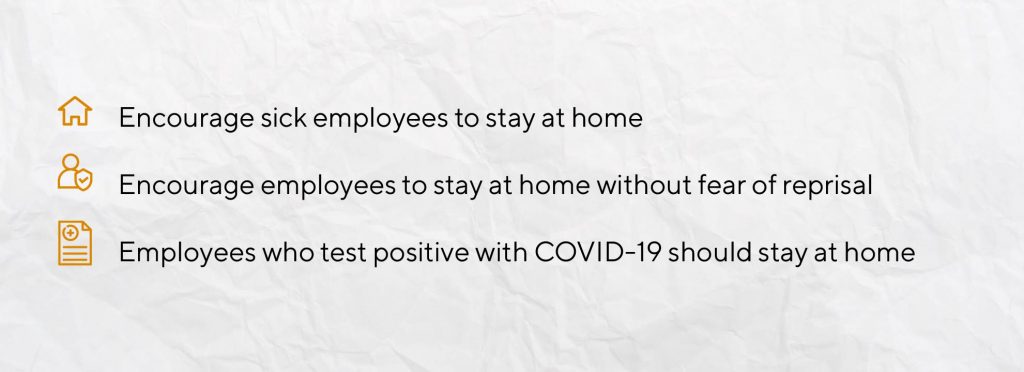
#3 Hand Washing
To reduce the spread of the virus, enforce stringent hand washing. It’s best to have a set schedule for this, such as once per hour. Employees should also wash hands:
-
Before preparing food
-
While preparing food
-
After preparing food
-
After touching garbage
Employees should wash with soap and water for at least 20 seconds.
Note that you’ll likely have to increase monitoring to ensure adherence. Employees may not voluntarily wash their hands according to your schedule. Consequently, your managers may need to be vigilant for a few weeks until the stricter hygiene procedure becomes habit.
Employees should cover coughs and sneezes with tissue. But used tissues should be discarded immediately, and employees should wash their hands at once. If you run out of soap during business hours, you can use hand sanitizer composed of up to 60% alcohol. Note that this is only a temporary measure. The ideal situation is to use both soap and hand sanitizer in tandem.
#4 Face Coverings
If feasible, require employees to use cloth face coverings. Note that in some areas, this may be required by law or by temporary statute. Cloth face coverings are important for preventing the spread of the virus in environments like yours, where social distancing is impossible or difficult. Staff in the following areas in particular should use them:
-
The kitchen
-
Stockroom workers, loading and unloading inventory
-
Wait staff
However, you should never place a cloth face covering on the following individuals:
-
Children
-
Anyone who has breathing difficulties
-
Anyone who has lost consciousness
-
Anyone who can’t remove a face mask without help
With this in mind, let’s imagine a scenario. Say one of your managers needs to do inventory, but they have a young child and no babysitter—as can happen. And let’s say this employee believes they have no choice but to bring their child to, say, the break room while she counts. This is not ideal. But it happens.
In this scenario, she would wear a face mask while on the premises, but her child cannot. Consequently, it’s best to be firm here and insist that she do her inventory at another time—such as when she can do so alone.
The truth is cloth face coverings can only do so much. They won’t prevent infection 100% of the time, but they’re certainly better than nothing. These masks can lower viral load, meaning that they can reduce your exposure to the virus itself. This can have an impact on how severe your symptoms are if you contract COVID.
#5 Supplies
Keep your stock of cleaning supplies up to snuff. Customers and employees alike want to see that you’re able to protect them. Supplies to keep stocked at all times—as feasible—include:
-
Soap
-
Hand sanitizer
-
Paper towels
-
No touch foot pedal trash cans
-
Tissues
-
Cloth face coverings
-
Disinfectant wipes
#6 Signs
The CDC website provides signs that you can print and post. These promote COVID-19 safety. While you can print these on your own, you can also take these files to a professional print shop.
The CDC provides signs for:
-
Various protective measures
-
How to slow the spread
-
The proper way to wash hands
-
Wearing a face mask covering properly
Please post these signs in frequently traveled areas, such as restrooms, entrances, etc. The CDC also provides videos on how to properly navigate the COVID crisis. You can share these with vendors, employees and staff at various places on your website.
Promoting Health
Until a vaccine is developed, it’s crucial that you do all you can to promote the health and wellbeing of staff and guests. Let’s explore a few ways to do so.
#1 Clean & Disinfect
All frequently touched surfaces should be cleaned and disinfected on a regular basis. This includes:
-
Cash registers & touch screens
-
Mobile devices
-
Workstations
-
Sink handles
-
Bathroom stalls
-
Door handles
At minimum, your staff should clean these surfaces daily. However, more is certainly better. Keep in mind that general food safety may require certain surfaces to be cleaned more often. Naturally, you would also want to keep follow any standard food safety laws, rules or regulations.
Next, make sure you’re using cleaning products that meet or exceed EPA disinfection criteria. Please note that the manufacturer will specify the amount of time the disinfectant is to be left on a given surface. This information is usually listed on the back of the bottle.
Establishing a disinfection routine is essential. But training staff on this routine is equally important. Your staff must know how to safely apply the various disinfectants you use. If they don’t, they may contaminate food or permanently damage surfaces.
Food contact surfaces in particular must be cleaned with an EPA-approved food contact surface sanitizer. If you need to deep clean a surface due to blood, body fluid or suspected viral contamination, do the following:
-
Wash, rinse and disinfect the surface according to the instructions on the label
-
Then sanitize the surface with the appropriate food contact sanitizer
Wash tables thoroughly after using disinfects on them. This ensures that disinfectant residues are not left behind.
Make sure that disinfectants are stored securely and within safe temperatures. Naturally, you’ll always want to make sure these chemical cleaners are stored safely away from children.
When removing garbage bags or handling trash, always wash hands immediately after, even if you used gloves.
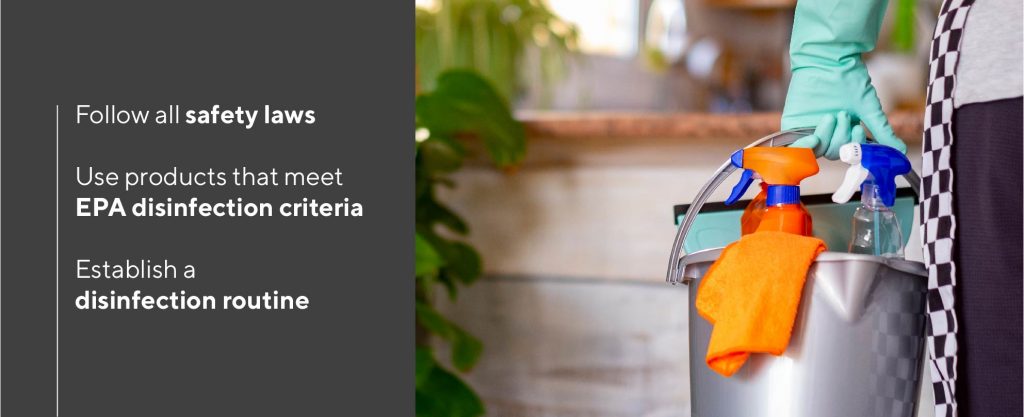
#2 Physical Barriers
Physical barriers like partitions, plastic face masks and sneeze guards keep your employees and customers safe. Install them where logical and feasible and have employees use them when they’re in frequent contact with customers. These barriers are particularly useful when it’s difficult or impossible to stay at least six feet apart. They can be useful in:
-
The kitchen
-
Cash registers
-
Food pickup areas
-
Host stands
Use physical guides to maintain foot traffic flow in your restaurant. For instance, you can place tape on the floor at six foot intervals. This simple step tells customers where to stand in order to maintain safe social distancing.
Consider closing communal spaces such as break rooms. Employees will congregate there out of habit. This increases the risk of virus transmission.
#3 Share Items Responsibly
There are numerous steps you should take to ensure that your staff shares objects responsibly. Let’s take a look.
-
If an item is difficult to clean or sanitize, discourage employees from sharing it with one another
-
Employees shouldn’t share food, tools or supplies unless absolutely necessary
-
Make sure that you keep supplies adequately stocked to discourage sharing as much as possible
-
High-touch materials like serving spoons should be cleaned often, but only with safe disinfectants, as these items are often used with food
-
If a tool must be shared, limit its use to one group of employees at a time—staff should clean said tool before passing it on to another group
-
Employees should not share reusable items like menus, food containers and condiments—doing so turns these items into high-touch materials that are difficult and time consuming to clean
-
To avoid the above, use disposable or disposable menus whenever possible
-
Use touchless payment technologies whenever possible
-
Ask customers to place their cash or card on a tray or other neutral item—doing so limits direct hand-to-hand contact
-
Frequently disinfect pens, counters and hard surfaces
-
Encourage customers to bring and use their own pens
-
Whenever possible, use disposable tablecloths, napkins, dishes and other items
-
If you can’t use disposable items, make sure that employees handle these items with gloves—employees should then regularly wash the items with soap and warm water
-
Launder and change linen items regularly—if feasible, do so after each customer use
-
Employees should remember to wash their hands after removing gloves
-
Do not allow customers to bring their own utensils or beverage containers into your establishment
#4 Ventilate Your Space
Perform regular maintenance on your ventilation system. The goal is to ensure that you’re circulating as much outdoor air as you can. This removes droplets and aerosols from your premises. In addition, consider increasing circulation of outdoor air as much as possible by opening your windows. Also encourage outdoor dining whenever possible. However, be cognizant of the fact that opening windows may pose issues for certain customers. Doing so may trigger allergies or asthma symptoms.
#5 Water Management
Humans are susceptible to certain waterborne illnesses, such as Legionnaires’ disease. To minimize this risk, test your water systems to ensure they’re safe to use after a shutdown of any length. Check and test:
-
Decorative fountains
-
Drinking faucets
-
Sink faucets
#6 Modified Procedures
There are many ways you can modify your standard procedures to make yourself better prepared for COVID. Let’s take a look.
-
Change your indoor seating layout as soon as possible to ensure that all parties are at least six feet apart
-
Reduce the number of tables you serve at once—doing so allows for social distancing
-
If you don’t already, try to offer curbside pickup, drive through and delivery
-
Ask customers to wait in their cars instead of coming in for pickup
-
Post your new pickup and delivery policies on your website so customers don’t have to ask in person
-
Eliminate the need for waiting areas by using text alerts, apps or signs to let people know when their table is ready
-
Trim your menu so that patrons will choose their entree faster—this will also make your kitchen more efficient
-
Reduce or eliminate self-service options like drink stations, salad bars or drink stations
Optimal Operations
It’s important to slow the spread of the virus by observing proper social distancing and sanitation practices. But it’s also imperative to maintain healthy operations. Doing so will help you maintain your bottom line. In this section, we’ll look at several best practices. Let’s get started.
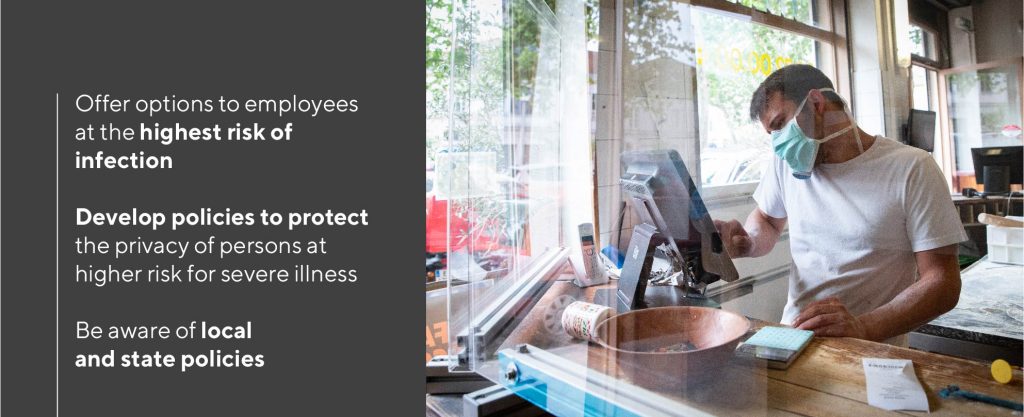
#1 High Risk Employees
Some employees are at higher risk for COVID than others. Know who these employees are so you can help keep them safe.
These are:
-
Anyone over the age of 60
-
Anyone with pre-existing medical conditions such as cancer, kidney disease, COPD, any heart condition, sickle cell disease, type 2 diabetes, and Immunocompromised individuals.
One popular option among restaurant owners is to offer these folks modified duties. For instance, managers may be able to hold meetings with employees via teleconference. Managers that usually manage deposits may instead do inventory. This way, they don’t have to handle money that may be contaminated.
#2 Regulations
Be aware that your area may have its own regulations and statues with regards to large gatherings or restaurant seating. Attend town meetings and other events to stay up to date.
#3 Shifts
It’s a good idea right now to limit the number of people in your restaurant at once. Staggering shifts is a great way to do this. For instance, some restaurants have taken to offering dine-in service only every other day. If you offer breakfast, but it’s not a key component of your revenue or brand, you may also consider suspending breakfast service for now. This can save money on your power and water bills.
Telework, coupled with flexible work hours, can make it easier for employees to become accustomed to new and different work conditions. This will also make it easier for them to social distancing guidelines and procedures.
#4 Meetings & Gatherings
It’s important to maintain proper social distancing until this crisis comes to an end. So for now, avoid social events where it’s impossible to space people at least six feet apart. This includes:
-
Group events
-
Gatherings
-
Catered parties
-
Meetings
#5 Travel
Identify employees who seem to use ride sharing or public transportation to get to work. Encourage them to bike or walk instead, where possible. Any option that minimizes contact with others is good. If employees cannot change their current commute, emphasize the importance of hand washing. Make it clear that they’re to wash their hands immediately upon arriving at your restaurant.
#6 COVID Point of Contact
Designate one person per shift to be responsible for COVID-19 related matters. This person responds to employee or customer concerns. Make sure that everyone on each shift knows who this person is. Typically, this will be a member of management.
#7 Communication
You may want to put a system in place that allows employees to self-report the following:
-
Having come into contact with an individual suffering from COVID-19
-
Having tested positive for the same
-
Having symptoms of the same
#8 Sick Leave
Particularly now, it’s important to have a flexible sick leave policy. This policy should allow people to stay at home when:
-
They are sick
-
They have been exposed to COVID-19
-
They are caring for someone who is sick
A good place to start is to review your existing policies. Check for outdated policies that are unnecessary restrictive or harsh. Note that leave policies should not be punitive, especially not now. Avoid punishing people for taking time off. Your policy should also take into account people who have to stay home because of illness in the family.
On the other hand, be sure to develop a policy that helps people who have had COVID return to work.
To defend yourself against employees who may take advantage of more lenient policies, you can:
-
Monitor non-COVID related absenteeism
-
Cross-train your staff
-
Hire backup staff if possible
We sincerely hope that this post has been of use to you. If you found it useful, could you give it a share? We’d appreciate it!





